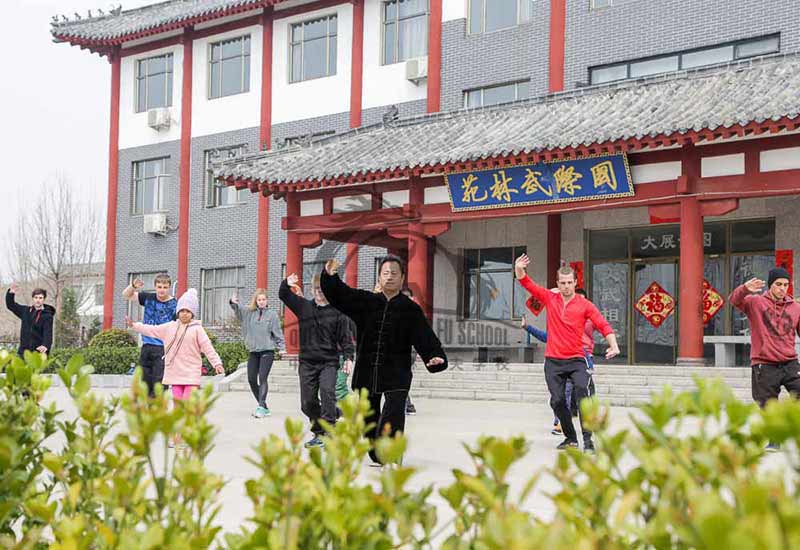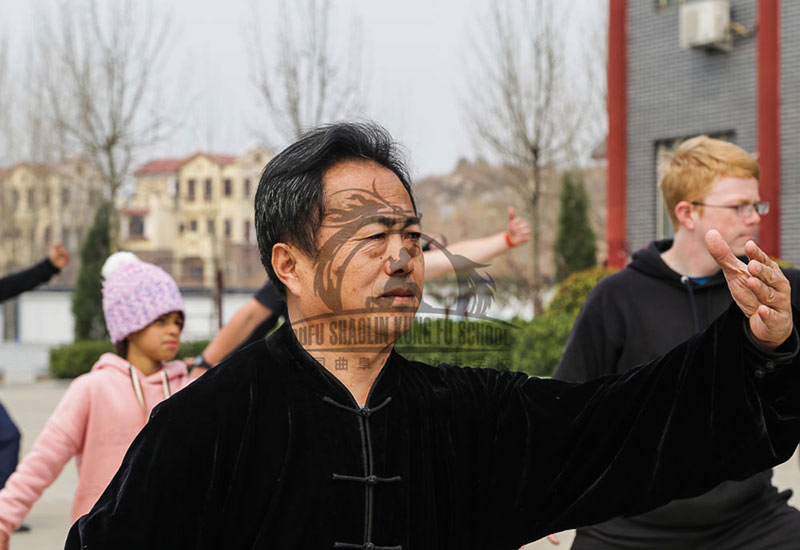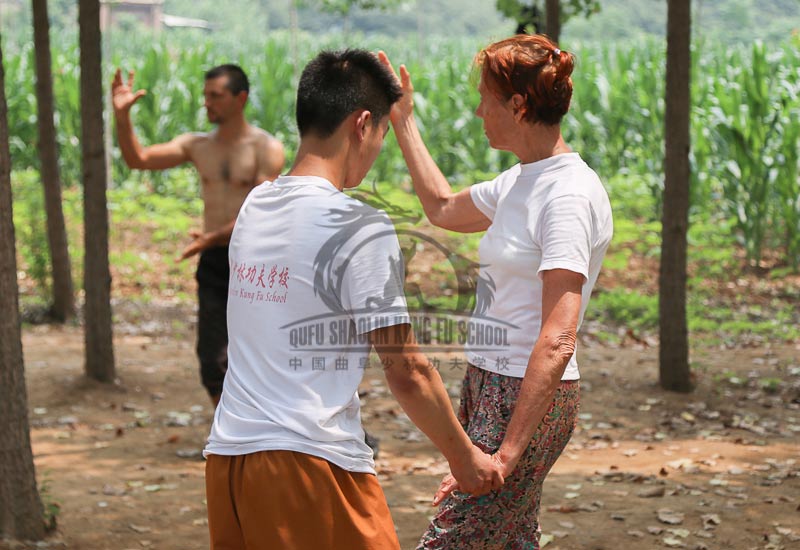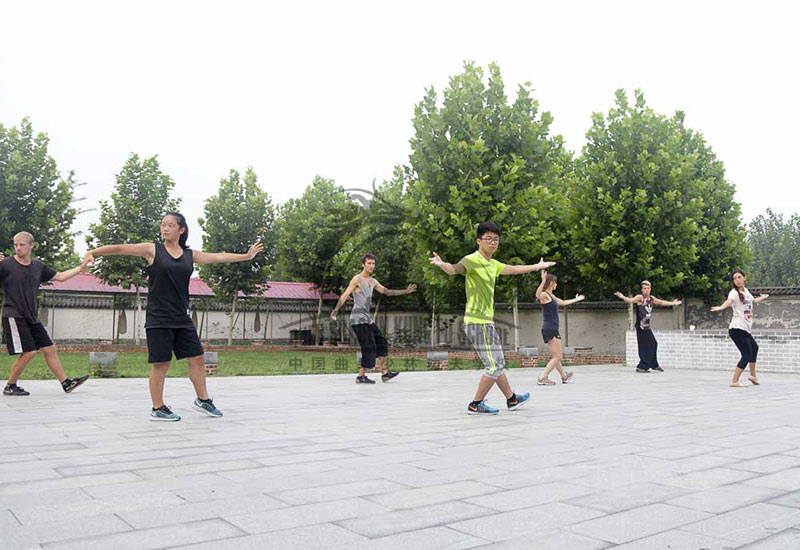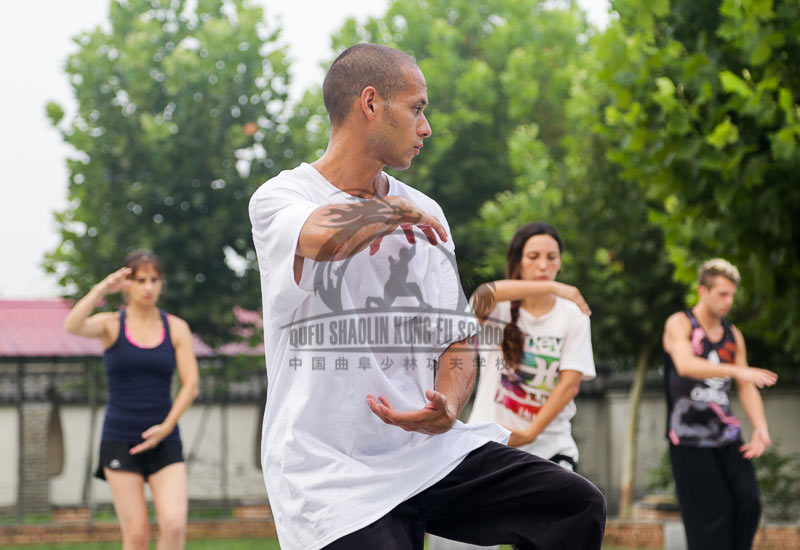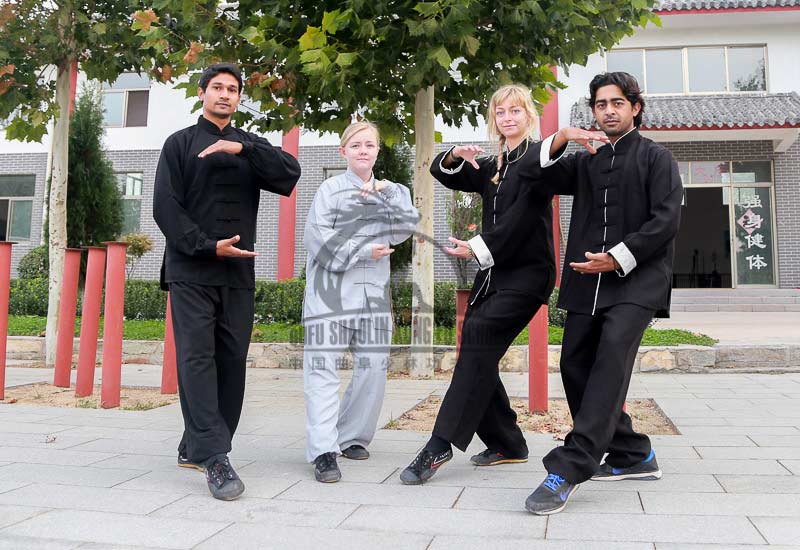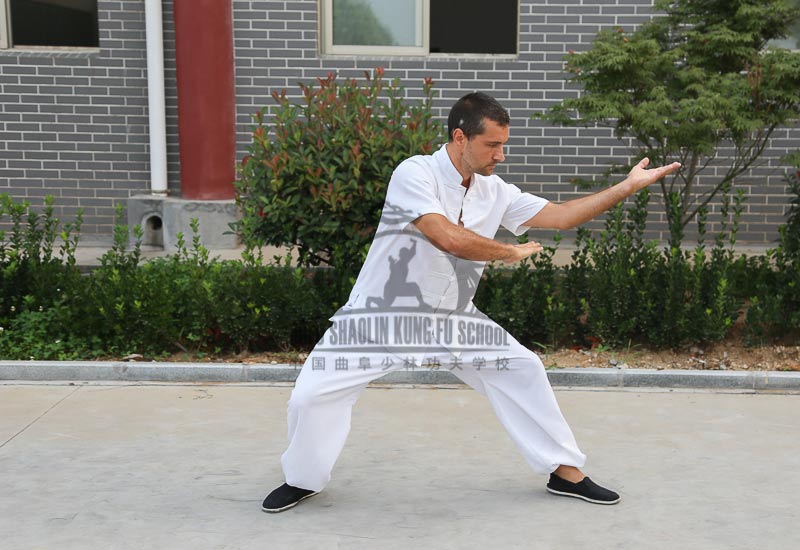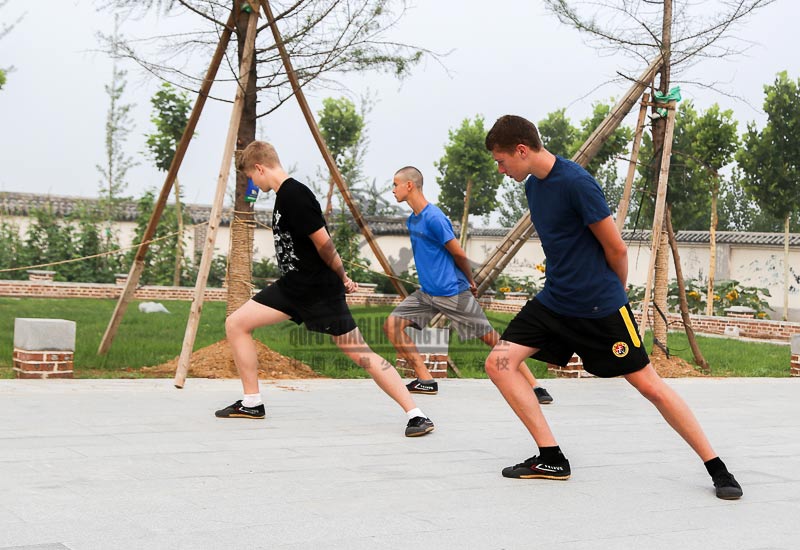Tai Chi (Tai Ji)
太极
Tai Chi (Tai Ji)
Study Tai Chi in Qufu Shaolin Kung fu school China. Want to learn Tai Ji in China? The School offers Tai Chi courses and training for diferent skill levels. Study Traditional TaiJi, training with real kung fu masters. ...
Apply now Taiji (the `supreme ultimate` school) was derived from Wuji ('emptiness'; the `non-ultimate` school) and composed of two different states (liang yi)Yin and Yang. From Liang Yi came sancai (the 'three components') and sixiang (the 'four kinds of appearances'). Bagua (Eight Symbols) also came from sixiang. Tai Chi is often thought of as being quintessential of China, entailing the principles of Yin and Yang from the I Ching, (the Book of Changes), rooted in Chinese medicine (meridians and specific names of vessels), with the meditative aspect of it's practice in focusing on the breath. Tai Chi is a comprehensive study and characterized by the interaction of the energies of Yin and Yang. It's creation brought together an understanding of the laws of the human body with those of nature- alternating force and flexibility with swiftness and slowness.
As force and flexibility are compatible within, Tai Chi can be used to defend, attack and strengthen body as well as prevent and help cure illness. It is suited to peple of any age, gender or body form.
Tai Chi is widely practiced in China. It's history stretches back many years and it's different schools have contributed to it's widespread practice. Stories about the origination and spread of Tai Chi have always existed among martial artists and passed on from them in the oral tradition.
In the ancient Chinese text `Detailed Explanation on Postures of Taiji Sword and Tai Chi` written by the South Yue dynasty prime minister Wen Jinzhi , there is a written account on the origination of Tai Chi. The passage reads that there was a man named Zhang Sanfeng who was born in Yizhou in Liaodong province. He could run 1000 kilometers a day. In the early years of HongWu in the Ming Dynasty (1368-1644), he went to Shu (now Sichuan ) Province to help build a road. In the 27th year of Hongwu, he came to Wudang mountain to recite lection. One day, a magpie flew into the yard and perched on the tree. He followed the sound he heard of the bird until through a window, Zhang saw the bird above and a snake below on the ground staring at each other, preparing to fight. When the bird assaulted down on the snake, the bird and the snake were propelled into fierce action, but the snake moved its body with slight action and waved away the bird every time without being injured. Zhang was rather impressed and realised that changes can be conquered by immobility and that flexibility can overcome force.
Former Tai Chi was known as Changquan (long-boxing), with 13 sets of posture. Later, Wang Zongyue changed its name to Taiji, in accordance with the principles of Yin and Yang in the Books of Changes.
Though the varying schools of Tai Chi differ from each other in their routines, hand pushing techniques and forms, they all provide equivalent benefit: stimulation to?blood circulation, adjusting vitality distribution, nitrating internal organs and strengthening the body.
As one of the arts of boxing, Tai Chi was once called changqun (long boxing), mianquan (soft boxing) , 13shi (13 postures) and ruanshou (soft hand). Only after the years of Qianlong (Qing dynasty 1736-1795), when martial artist Wang Zongyue wrote a book named `on Tai Chi` was it's name widely accepted. The word Taiji was first seen however in the book the `Changes of Zhou Xici` having the combined meaning of supreme, utmost, absolute and uniqueness.
In the practice of Tai Chi, every move is to be felt peaceful and comfortable. Acts are light and agile, slow and smooth. Loose and tight movements are in order as is force and flexibility correlated. Tai Chi is revered for being a practice of natural and elegant movements that are immersed in musical rhythm, philosophical connotation, styles of beauty and poetic atmosphere. It's beneficial natureto health can heal, prevent illness and facilitate the enjoyment of life.
Research from many fields including medicine, physics, chemistry, anatomy, psychology etc. have shown that practicing Tai Chi plays a beneficial role in the prevention and cure of chronic diseases, such as high blood pressure, heart disease, pulmonary disease, hepatitis, naturopathy, intestines and neurasthenia etc.
Theory of skills of attack
Tai Chi has a unique style of attacking. It implies immobility as conquering change and flexibility as suppressing force. Tai Chi also teaches to avoid the enemy's main forces, strike the weak point and use the force received to defend. The practitioner changes their movement in accordance with that of others; otherwise they may be trapped by themselves. In doing so, Tai Chi emphasizes the ability to sense, that is to correctly and quickly make a judgment about any opposition and thereby respond. If the opposite side does not take initiative, as a practitioner, you should also keep still. Under such situation, you may first provocate the other side so as to get information of his ability. So long as the other side started, you should make a quicker move, faster than the opposite even before he moves. Win by striking only after the enemy has struck first. Invite the opponent in, break up his strike or deviate his force, take the advantage of the weak point and retaliate upon it. The theory of Tai Chi in attack lies in the hand pushing and move routine, which not only is conducive to the training of body skills such as response, power and speed etc., but also an important part of attack and defense training.
Tai Chi follows the principle of Yin and Yang, the attack process focuses the inviting combined with the breaking up. During attack and defense, you sense the opposite force and force's direction by the ability to sense and break up the coming force. Using the force received to defend, ie. changes of move following the opposite changes.
Basic moves
The basic actions of Tai Chi are tightening, quivering, stroking, squeezing, elbowing, shoving, advancing, receding, considering, waiting, and stillness.
Every act is slow and relaxing. In Tai Chi drill, one should straighten back and waist, draw in the jaw, and droop the shoulder, with a feeling of flying across the clouds. A certain boxer in the Qing Dynasty once said of Tai Chi "act as the wave of the sea, torrential and never-failing."
Tai Chi at the same time also pays much attention of the training of Qi and breath control. Qi is to refine human's mentality and lies at the heart of Tai Chi as with other forms of internal Kungfu.
To learn Tai Chi
Follow your thought and keep calm. Maintain a natural breath. You are required to fix attention and rest your thought, concentrate on action; move and breathe smoothly and never try to block your breath. Sit straight and move slowly and softly. You should keep a relaxed and natural posture, do not lean askew. Every act is fluent and smooth, like wind flying, water flowing. A round and complete radiance in every act. You are demanded to make acts move as arc or spiral, one after another without block. Your waist stays as axis, with which the whole body is oriented on. Act fluently and coherently, weakness and force in company. Your acts are to be closely connected, weakness and force distinguished, while center of power always remaining stable. Agile and smoothly act with softness and power mutually corresponded. Every act is required to be light and stable, but not buoyant or stark. Acts are soft but powerful within, full of flexibility.Strength is exerted but done so in consciousness and without any sense of clumsiness.
The Teaching Plan of Tai-chi Class
● The basics in martial arts
Legs exercises: stretching, front kick, side-way kick, single swing lotus kick, double swing lotus kick, one-leg standing, double kicks, tornado kick
Stances exercises: bow stance, horse stance, crouch stance, empty stance, resting stance
Hands exercises includes palm techniques and hand forms
Body position exercise: Keep body flexible, straight, natural and coordinate.
● The basics of Tai-chi
Besides the basics of martial arts, standing stake exercise is also needed in Tai-chi. Standing stake exercise is the basics of Tai-chi, just like the base of building. There are two kinds of standing stake exercise, fixed step exercise and live step exercise. The fixed standing stake exercise includes the non-polar exercise, supreme pole exercise, elevator exercise and spinning universe exercise.
The live standing stake exercise includes front-hand circling of left and right side, back-hand fist of left and right side, fixed standing and clouds hands, live standing with upper clouds hands, live standing with middle clouds hands, live standing with lower clouds hands, wild horses parting its manes on both sides, brush knee and twist the steps, repulse monkey, etc.
● Tai-chi forms exercise
1. National standard forms include the simplified 24 forms, the comprehensive 32 forms, the competitive 42 forms, the standard 48 forms of Yang style and the simplified 56 forms of Chen style.
2. In the practical Chen style form, there are 81 movements in the first section and 64 movements in the second section.
3. The east mountain Tai-chi
4. The weapons forms include the 49 straight forms in Chen style, the 23 broadsword forms, the 132 straight forms of Wudang, the 29 straight sword of east mountain, the 154 Niulang staff form, the four-section peace single broadsword.
5. With the base of basic conditioning and forms training, the hand-pushes exercise, the applications of Tai-chi forms and the usage of the eight in the real competition are needed.(the eight methods of Tai-chi: bouncing, stroking, squeezing, pressing, gathering, liet, elbow, colliding.
6. The optional items include Dahong of Shaolin, the 12 sections snap kick of Shaolin, Xingyi the five elements continuous form, the health cultivation eight-steps Qigong, the 6 sections health cultivation, etc.
As force and flexibility are compatible within, Tai Chi can be used to defend, attack and strengthen body as well as prevent and help cure illness. It is suited to peple of any age, gender or body form.
Tai Chi is widely practiced in China. It's history stretches back many years and it's different schools have contributed to it's widespread practice. Stories about the origination and spread of Tai Chi have always existed among martial artists and passed on from them in the oral tradition.
In the ancient Chinese text `Detailed Explanation on Postures of Taiji Sword and Tai Chi` written by the South Yue dynasty prime minister Wen Jinzhi , there is a written account on the origination of Tai Chi. The passage reads that there was a man named Zhang Sanfeng who was born in Yizhou in Liaodong province. He could run 1000 kilometers a day. In the early years of HongWu in the Ming Dynasty (1368-1644), he went to Shu (now Sichuan ) Province to help build a road. In the 27th year of Hongwu, he came to Wudang mountain to recite lection. One day, a magpie flew into the yard and perched on the tree. He followed the sound he heard of the bird until through a window, Zhang saw the bird above and a snake below on the ground staring at each other, preparing to fight. When the bird assaulted down on the snake, the bird and the snake were propelled into fierce action, but the snake moved its body with slight action and waved away the bird every time without being injured. Zhang was rather impressed and realised that changes can be conquered by immobility and that flexibility can overcome force.
Former Tai Chi was known as Changquan (long-boxing), with 13 sets of posture. Later, Wang Zongyue changed its name to Taiji, in accordance with the principles of Yin and Yang in the Books of Changes.
Though the varying schools of Tai Chi differ from each other in their routines, hand pushing techniques and forms, they all provide equivalent benefit: stimulation to?blood circulation, adjusting vitality distribution, nitrating internal organs and strengthening the body.
As one of the arts of boxing, Tai Chi was once called changqun (long boxing), mianquan (soft boxing) , 13shi (13 postures) and ruanshou (soft hand). Only after the years of Qianlong (Qing dynasty 1736-1795), when martial artist Wang Zongyue wrote a book named `on Tai Chi` was it's name widely accepted. The word Taiji was first seen however in the book the `Changes of Zhou Xici` having the combined meaning of supreme, utmost, absolute and uniqueness.
In the practice of Tai Chi, every move is to be felt peaceful and comfortable. Acts are light and agile, slow and smooth. Loose and tight movements are in order as is force and flexibility correlated. Tai Chi is revered for being a practice of natural and elegant movements that are immersed in musical rhythm, philosophical connotation, styles of beauty and poetic atmosphere. It's beneficial natureto health can heal, prevent illness and facilitate the enjoyment of life.
Research from many fields including medicine, physics, chemistry, anatomy, psychology etc. have shown that practicing Tai Chi plays a beneficial role in the prevention and cure of chronic diseases, such as high blood pressure, heart disease, pulmonary disease, hepatitis, naturopathy, intestines and neurasthenia etc.
Theory of skills of attack
Tai Chi has a unique style of attacking. It implies immobility as conquering change and flexibility as suppressing force. Tai Chi also teaches to avoid the enemy's main forces, strike the weak point and use the force received to defend. The practitioner changes their movement in accordance with that of others; otherwise they may be trapped by themselves. In doing so, Tai Chi emphasizes the ability to sense, that is to correctly and quickly make a judgment about any opposition and thereby respond. If the opposite side does not take initiative, as a practitioner, you should also keep still. Under such situation, you may first provocate the other side so as to get information of his ability. So long as the other side started, you should make a quicker move, faster than the opposite even before he moves. Win by striking only after the enemy has struck first. Invite the opponent in, break up his strike or deviate his force, take the advantage of the weak point and retaliate upon it. The theory of Tai Chi in attack lies in the hand pushing and move routine, which not only is conducive to the training of body skills such as response, power and speed etc., but also an important part of attack and defense training.
Tai Chi follows the principle of Yin and Yang, the attack process focuses the inviting combined with the breaking up. During attack and defense, you sense the opposite force and force's direction by the ability to sense and break up the coming force. Using the force received to defend, ie. changes of move following the opposite changes.
Basic moves
The basic actions of Tai Chi are tightening, quivering, stroking, squeezing, elbowing, shoving, advancing, receding, considering, waiting, and stillness.
Every act is slow and relaxing. In Tai Chi drill, one should straighten back and waist, draw in the jaw, and droop the shoulder, with a feeling of flying across the clouds. A certain boxer in the Qing Dynasty once said of Tai Chi "act as the wave of the sea, torrential and never-failing."
Tai Chi at the same time also pays much attention of the training of Qi and breath control. Qi is to refine human's mentality and lies at the heart of Tai Chi as with other forms of internal Kungfu.
To learn Tai Chi
Follow your thought and keep calm. Maintain a natural breath. You are required to fix attention and rest your thought, concentrate on action; move and breathe smoothly and never try to block your breath. Sit straight and move slowly and softly. You should keep a relaxed and natural posture, do not lean askew. Every act is fluent and smooth, like wind flying, water flowing. A round and complete radiance in every act. You are demanded to make acts move as arc or spiral, one after another without block. Your waist stays as axis, with which the whole body is oriented on. Act fluently and coherently, weakness and force in company. Your acts are to be closely connected, weakness and force distinguished, while center of power always remaining stable. Agile and smoothly act with softness and power mutually corresponded. Every act is required to be light and stable, but not buoyant or stark. Acts are soft but powerful within, full of flexibility.Strength is exerted but done so in consciousness and without any sense of clumsiness.
The Teaching Plan of Tai-chi Class
● The basics in martial arts
Legs exercises: stretching, front kick, side-way kick, single swing lotus kick, double swing lotus kick, one-leg standing, double kicks, tornado kick
Stances exercises: bow stance, horse stance, crouch stance, empty stance, resting stance
Hands exercises includes palm techniques and hand forms
Body position exercise: Keep body flexible, straight, natural and coordinate.
● The basics of Tai-chi
Besides the basics of martial arts, standing stake exercise is also needed in Tai-chi. Standing stake exercise is the basics of Tai-chi, just like the base of building. There are two kinds of standing stake exercise, fixed step exercise and live step exercise. The fixed standing stake exercise includes the non-polar exercise, supreme pole exercise, elevator exercise and spinning universe exercise.
The live standing stake exercise includes front-hand circling of left and right side, back-hand fist of left and right side, fixed standing and clouds hands, live standing with upper clouds hands, live standing with middle clouds hands, live standing with lower clouds hands, wild horses parting its manes on both sides, brush knee and twist the steps, repulse monkey, etc.
● Tai-chi forms exercise
1. National standard forms include the simplified 24 forms, the comprehensive 32 forms, the competitive 42 forms, the standard 48 forms of Yang style and the simplified 56 forms of Chen style.
2. In the practical Chen style form, there are 81 movements in the first section and 64 movements in the second section.
3. The east mountain Tai-chi
4. The weapons forms include the 49 straight forms in Chen style, the 23 broadsword forms, the 132 straight forms of Wudang, the 29 straight sword of east mountain, the 154 Niulang staff form, the four-section peace single broadsword.
5. With the base of basic conditioning and forms training, the hand-pushes exercise, the applications of Tai-chi forms and the usage of the eight in the real competition are needed.(the eight methods of Tai-chi: bouncing, stroking, squeezing, pressing, gathering, liet, elbow, colliding.
6. The optional items include Dahong of Shaolin, the 12 sections snap kick of Shaolin, Xingyi the five elements continuous form, the health cultivation eight-steps Qigong, the 6 sections health cultivation, etc.
Related Masters:
Share It :
Copyright © 2008-2025 Qufu Shaolin Kung Fu School All Rights Reserved 鲁ICP备09020273号
You can find ours here Terms of Service, our Data protection and our Cookie-Richtlinie
You can find ours here Terms of Service, our Data protection and our Cookie-Richtlinie


